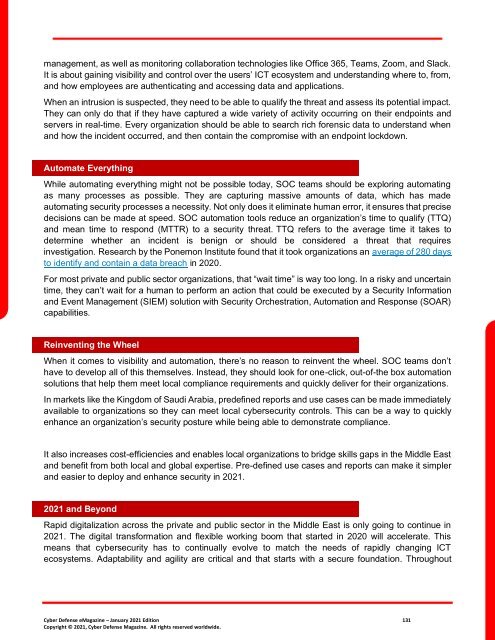Cyber Defense eMagazine January 2021 Edition
Cyber Defense eMagazine January Edition for 2021 #CDM #CYBERDEFENSEMAG @CyberDefenseMag by @Miliefsky a world-renowned cyber security expert and the Publisher of Cyber Defense Magazine as part of the Cyber Defense Media Group as well as Yan Ross, US Editor-in-Chief, Pieruligi Paganini, Co-founder & International Editor-in-Chief, Stevin Miliefsky, President and many more writers, partners and supporters who make this an awesome publication! Thank you all and to our readers! OSINT ROCKS! #CDM #CDMG #OSINT #CYBERSECURITY #INFOSEC #BEST #PRACTICES #TIPS #TECHNIQUES
Cyber Defense eMagazine January Edition for 2021 #CDM #CYBERDEFENSEMAG @CyberDefenseMag by @Miliefsky a world-renowned cyber security expert and the Publisher of Cyber Defense Magazine as part of the Cyber Defense Media Group as well as Yan Ross, US Editor-in-Chief, Pieruligi Paganini, Co-founder & International Editor-in-Chief, Stevin Miliefsky, President and many more writers, partners and supporters who make this an awesome publication! Thank you all and to our readers! OSINT ROCKS! #CDM #CDMG #OSINT #CYBERSECURITY #INFOSEC #BEST #PRACTICES #TIPS #TECHNIQUES
Create successful ePaper yourself
Turn your PDF publications into a flip-book with our unique Google optimized e-Paper software.
management, as well as monitoring collaboration technologies like Office 365, Teams, Zoom, and Slack.<br />
It is about gaining visibility and control over the users’ ICT ecosystem and understanding where to, from,<br />
and how employees are authenticating and accessing data and applications.<br />
When an intrusion is suspected, they need to be able to qualify the threat and assess its potential impact.<br />
They can only do that if they have captured a wide variety of activity occurring on their endpoints and<br />
servers in real-time. Every organization should be able to search rich forensic data to understand when<br />
and how the incident occurred, and then contain the compromise with an endpoint lockdown.<br />
Automate Everything<br />
While automating everything might not be possible today, SOC teams should be exploring automating<br />
as many processes as possible. They are capturing massive amounts of data, which has made<br />
automating security processes a necessity. Not only does it eliminate human error, it ensures that precise<br />
decisions can be made at speed. SOC automation tools reduce an organization’s time to qualify (TTQ)<br />
and mean time to respond (MTTR) to a security threat. TTQ refers to the average time it takes to<br />
determine whether an incident is benign or should be considered a threat that requires<br />
investigation. Research by the Ponemon Institute found that it took organizations an average of 280 days<br />
to identify and contain a data breach in 2020.<br />
For most private and public sector organizations, that “wait time” is way too long. In a risky and uncertain<br />
time, they can’t wait for a human to perform an action that could be executed by a Security Information<br />
and Event Management (SIEM) solution with Security Orchestration, Automation and Response (SOAR)<br />
capabilities.<br />
Reinventing the Wheel<br />
When it comes to visibility and automation, there’s no reason to reinvent the wheel. SOC teams don’t<br />
have to develop all of this themselves. Instead, they should look for one-click, out-of-the box automation<br />
solutions that help them meet local compliance requirements and quickly deliver for their organizations.<br />
In markets like the Kingdom of Saudi Arabia, predefined reports and use cases can be made immediately<br />
available to organizations so they can meet local cybersecurity controls. This can be a way to quickly<br />
enhance an organization’s security posture while being able to demonstrate compliance.<br />
It also increases cost-efficiencies and enables local organizations to bridge skills gaps in the Middle East<br />
and benefit from both local and global expertise. Pre-defined use cases and reports can make it simpler<br />
and easier to deploy and enhance security in <strong>2021</strong>.<br />
<strong>2021</strong> and Beyond<br />
Rapid digitalization across the private and public sector in the Middle East is only going to continue in<br />
<strong>2021</strong>. The digital transformation and flexible working boom that started in 2020 will accelerate. This<br />
means that cybersecurity has to continually evolve to match the needs of rapidly changing ICT<br />
ecosystems. Adaptability and agility are critical and that starts with a secure foundation. Throughout<br />
<strong>Cyber</strong> <strong>Defense</strong> <strong>eMagazine</strong> – <strong>January</strong> <strong>2021</strong> <strong>Edition</strong> 131<br />
Copyright © <strong>2021</strong>, <strong>Cyber</strong> <strong>Defense</strong> Magazine. All rights reserved worldwide.


















